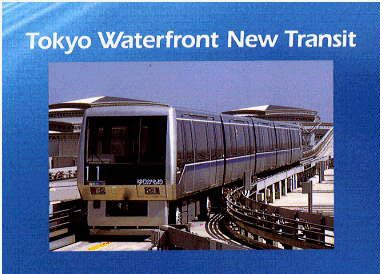Tokyo Teleport Town New Circulator Transit System
 The Tokyo Teleport Town has been developed along the
edge of Tokyo Bay as part of an effort to convert the urban structure of Tokyo to a
multi-centered urban form as opposed to it current monocentric form. To serve this
Teleport Town, a transit system was constructed, beginning in 1989. It was opened for
service in 1995. It runs along the waterfront zone and is said to have carried about
29,000 passengers per day at the beginning, rising to around 43,000 in 1996. Growth in the
Teleport Town has been significantly slowed by a slow Japanese economy but significant
additional activity is anticipated in the future.
The Tokyo Teleport Town has been developed along the
edge of Tokyo Bay as part of an effort to convert the urban structure of Tokyo to a
multi-centered urban form as opposed to it current monocentric form. To serve this
Teleport Town, a transit system was constructed, beginning in 1989. It was opened for
service in 1995. It runs along the waterfront zone and is said to have carried about
29,000 passengers per day at the beginning, rising to around 43,000 in 1996. Growth in the
Teleport Town has been significantly slowed by a slow Japanese economy but significant
additional activity is anticipated in the future.
Figure 1 provides an overview of this circulator system. It is 12
km in length, has 12 stations and it takes 24 minutes to travel from one end to the other.
The line consists of an elevated double track. The vehicles are light in weight and use
pneumatic tires to run on a concrete track. Heat is provided in the guideway to prevent
service interruptions due to snow and ice. The total construction cost was 170 billion yen
(around 1.7 billion USD at an exchange rate of 100 yen to the USD).
Figure 2 shows the vehicle being used. The vehicles have four
wheels, are electrically-powered, have stainless steel bodies that are 8.5 meters long and
use pneumatic tires. There are designed for low noise and vibration. All stations are
built with an overhead double-deck design. The platform level is on the top, the concourse
level and the surrounding buildings are connected by pedestrian decks to make access to
the station easier. The stations are designed so that elderly and disabled persons can use
them very easily. Vehicle operation, electric power, signal safety, communications and the
equipment for fully-automatic operation are all linked together. Automatic train operation
equipment controls speed, starts, stops and the opening/closing of doors.
Figure 3 shows the vehicle crossing the Rainbow Bridge. This
route for this system now provides access to the Shimbashi station, which connects to the
station of a JR line and a subway line. A plan for extending it would link to a second
subway station. It's nickname is "YURIKAMOME" which means blackheaded gull in
Japanese, now the bird of Tokyo.
This description has been abstracted from a paper by Norihisa Tadakoshi and others
entitled Waterfront New Transit System in Tokyo. It was presented at the
Automated Peoplemovers V international conference held in Paris in June of 1996. It is
included, in printed form, in the Proceedings from this conference
which is available from the ASCE. Images were provided
by Professor Hirotaka Koike of Utsunomiya University in Japan and are very much
appreciated.

Last modified: August 23, 2002
 The Tokyo Teleport Town has been developed along the
edge of Tokyo Bay as part of an effort to convert the urban structure of Tokyo to a
multi-centered urban form as opposed to it current monocentric form. To serve this
Teleport Town, a transit system was constructed, beginning in 1989. It was opened for
service in 1995. It runs along the waterfront zone and is said to have carried about
29,000 passengers per day at the beginning, rising to around 43,000 in 1996. Growth in the
Teleport Town has been significantly slowed by a slow Japanese economy but significant
additional activity is anticipated in the future.
The Tokyo Teleport Town has been developed along the
edge of Tokyo Bay as part of an effort to convert the urban structure of Tokyo to a
multi-centered urban form as opposed to it current monocentric form. To serve this
Teleport Town, a transit system was constructed, beginning in 1989. It was opened for
service in 1995. It runs along the waterfront zone and is said to have carried about
29,000 passengers per day at the beginning, rising to around 43,000 in 1996. Growth in the
Teleport Town has been significantly slowed by a slow Japanese economy but significant
additional activity is anticipated in the future.